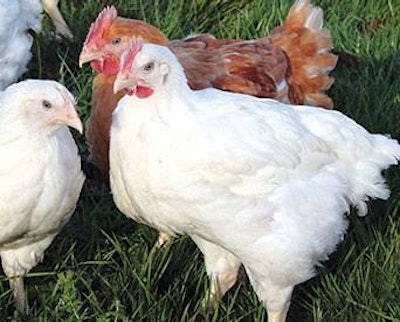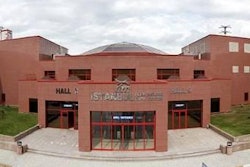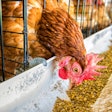
Human health experts say that “you are what you eat,” whilst those who are carrying extra pounds blame their genes. So, what about broilers – how much is efficiency determined by genetics, and how much by diet?
Poultry breeding companies have vastly improved the growth rates, feed conversion ratio (FCR) and age to slaughter over the last 50-plus years. These increases in efficiency are also due to nutritional and management changes. A highly successful broiler industry has resulted from these developments, but what does that mean in terms of bird welfare, sustainability and market demands?
How broilers have changed
The classic example of the differences between modern broilers and those reared over 50 years ago is a trial by North Carolina State University’s Gerald B. Havenstein in 2003. Performance and carcass characteristics of two broiler strains, Ross 308 and Athens-Canadian Random Bred Control (ACRBC), were compared when fed either a 1957- or 2001-type diet.
The modern broiler fed the 2001 feed was estimated to have reached a 1.815 kg body weight at 32 days of age with a FCR of 1.47. In comparison, the ACRBC broiler fed the 1957 diet would not have reached this weight until 101 days of age with a FCR of 4.42. These large differences can also be seen in the carcass composition of the ACRBC broiler compared to the modern broiler when both fed the same 2001 diet.
Comparing fast and slow-growing broilers
Modern fast-growing broilers are selected for high growth rates and breast meat yield.
Slow growing strains are produced for free-range, organic and other specific markets. Dr. Luc Maertens of Belgium’s Instituut voor Landbouw – en Visserijonderzoek (ILVO) presented a paper at the 2014 XIVth European Poultry Congress in Stavanger, Norway.
“I wanted to know whether fast-growing broilers are more efficient when fed the same daily feed quantity as a slower-growing strain,” he explained.
The experiment set out to separate the effects of feed intake, growth rate and age. In order to do this, the performance of a fast-growing strain (Ross 308) was compared when fed a commercial ration, either ad libitum or at a restricted level. This amount was set to be the same as the ad libitum intake of a slow-growing strain (Cobb Sasso) fed the same diet, which formed the third comparison.
Luc described the results of this trial as extremely interesting: “If we give the same quantity of feed to the fast growing broiler as the quantity that a slower growing broiler eats ad libitum, the efficiency is much higher (0.529 vs 0.433). This proves clearly the improved efficiency of selection.” (Table 1)
The lower FCR of ad libitum-fed, fast-growing broilers is partly the result of higher feed intake but also of increased efficiency. When the carcass composition was compared, the restricted fast-growing broilers were leaner than the slow-growing strains (8.9 percent vs. 14.8 percent fat) (Figure 1). “And even when fed ad libitum, the fast-growing broilers were still leaner (12.0 percent),” Luc says. “This can partly be explained by the increased breast meat (33.4 percent) yield, which is a very lean tissue.”
Genetic selection has increased efficiency. This is largely due to the increased feed intake (capacity) for a given age.
“As a result, a greater amount of nutrients and energy for production is available in these fast growing strains,” Luc stated, noting that maintenance requirements are only slightly higher because of the increased weight at the same age. “However, in our experiment we have demonstrated that genetic selection has improved efficiency independently of the feed intake.”
“Another interesting result was the whole carcass composition,” Luc continued. “In contrast to the general perception, fast-growing broilers are actually less fat than in the past.”
This is due to genetic selection, which partly explains why they are more efficient than before.
“This was the case for the fast-growing broiler when they were fed a restricted amount and ad libitum, compared to the slower-growing strain,” he concluded.
Welfare considerations
Are there welfare implications of birds growing faster?
At the European Poultry Congress, Marian Stamp Dawkins (Department of Zoology, University of Oxford, UK) gave a presentation on welfare and breeding in broilers. She believes that, in fact, improvements in efficiency and welfare should go hand in hand.
Whilst improvements in efficiency will be necessary to feed the ever-growing population, animal welfare is often included in the definition of agricultural sustainability.
Mortality is an important element of efficiency – birds that die have consumed and hence “wasted” feed. Therefore, efforts to prevent birds being injured or becoming diseased not only improve welfare, but also efficiency of the flock. Examples given include improving air and litter quality, both of which reduce ammonia levels; in turn, respiratory, leg and foot pad health increase.
Genetic improvements in innate immunity and disease resistance are also possible. Those who advocate “precision farming” state that is it important for animal welfare that these economic gains are built into efficient farming practices. Their research aims to explore the interactions between health, welfare, behavior and disease resistance.
The future of broiler genetics
Recent research has shown that these improvements are not only due to improved feed intake but inherent efficiency, along with changes in carcass composition. In certain regions, there is a growing market for poultry meat produced in alternative systems and, therefore, the use of slow-growing broilers is increasing. Whilst this kind of production is seen to be better for bird welfare, there are additional costs. But perhaps with genetic advancements, the efficiency of slow-growing broilers can be improved.
Geneticists believe that there is still plenty of room for improvement in terms of growth rates, carcass yield and feed efficiency, and health and welfare at the same time. They continue further developing the latest technology, making use of variation, drawing from a wider gene pool and assessing bird performance in different environments.
The belief that improvements in efficiency and welfare can go hand in hand – it is then essential that the breeding strategies broaden and develop further. Although health and robustness have always been important, there will always be new welfare-linked breeding traits developed and included. Just as the incidences of metabolic and skeletal disorders have already been significantly reduced. The requirement for agriculture to be both efficient and sustainable is growing, along with continued pressure to improve welfare; and genetics has a large role to play in these advancements.
















